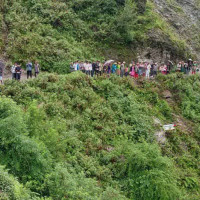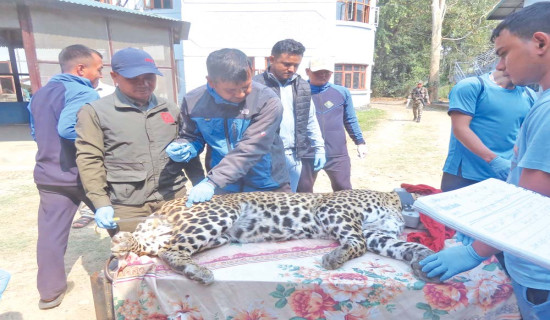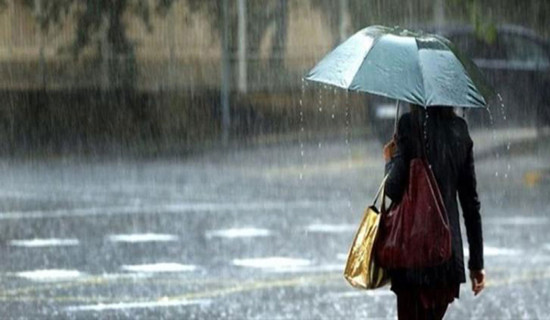- Friday, 22 August 2025
Challenges of fine tuning weather forecast accuracy
Kathmandu, Jan. 14: Despite the Department of Hydrology and Meteorology predicting above-normal rainfall for this winter (December to February) in its seasonal weather forecast, no rainfall has been recorded so far.
Issuing a special bulletin, the Department of Hydrology and Meteorology (DHM) forecast a 55 to 65 per cent chance of above-average rainfall in the northeast parts of Sudurpaschim Province and the northern parts of Karnali Province during these winter months.
It also predicted a 45 to 55 per cent chance of above-average rainfall in the eastern and southern parts of Sudurpaschim Province, southern parts of Karnali Province, all parts of Lumbini Province except the eastern parts, Gandaki Province, northwest parts of Bagmati Province, and northeast parts of Koshi Province.
The meteorological department also stated a 35 to 45 per cent chance of above-average rainfall in western parts of Sudurpaschim Province, eastern parts of Lumbini Province, central and southern parts of Bagmati Province, western parts of Madhesh Province, and northwest of Koshi Province.
There is a 35 to 45 per cent chance of below-average rainfall in the southern parts of Koshi Province and the central and eastern parts of Mahesh Province during the period. Yet, almost two months into the winter season, there has been no sign of precipitation across the country.
According to DHM data, this is not the only year below-normal rainfall recorded. Below-normal precipitation was recorded in 2016 (75% below normal), 2017 (60% below), 2018 (70% below), 2021 (76% below), and 2023 (79% below).
Why is the seasonal forecast questionable?
Bibuti Pokharel, Chief of the Climate Change Section under the DHM, mentioned that there is still one month left in the winter season this year. It is not yet time to determine whether the seasonal forecast has been true or not.
"Despite the absence of recorded rainfall thus far, our long-range forecast indicates discrepancies that we are actively studying. The seasonal outlook was formulated by integrating regional and global models, however, the forecast has exhibited uncertainty when compared to other countries. Additionally, predicting accurately poses a challenge due to our country's tropical structure and mountainous terrain,” Pokharel said.
"In our current situation, we are also dealing with climate change issues, and predictions are not 100 per cent accurate in mountainous countries like ours where the impact of climate change has been more pronounced in recent years. Another concern is the lack of data for calibration observation. We are working slowly to find solutions," she said.
The seasonal outlook preparation just began in the 2020 monsoon, and we are currently in the fourth year of seasonal forecasting. “Due to a lack of technology and trained human
resources, we have not divided the forecast into separate months. Forecasting for an entire season poses uncertainties. We are currently in discussions and planning to find a way to break down precipitation for each month,” Pokharel said.
According to Sudarshan Humagain, a meteorologist at DHM, the forecast was not provided every month, it was given for the whole season. “If we need to forecast monthly or fortnightly, we do not have that technology in Nepal. We are only able to provide a seasonal outlook, and it may not be 100 per cent accurate as we are only providing qualitative information. But what is true is that we are not seeing much improvement in this seasonal outlook as well.”
The seasonal outlook was prepared twice a year at the initial time in 2020, but this past October, we endeavoured to create forecasts for three seasons. The accuracy of the seasonal outlook remains low due to a lack of technology, limited knowledge, and insufficient human resources dedicated to the seasonal forecasting process, Humagain added.
He mentioned that the winter season comprises only three to four per cent of the total annual rainfall, and this percentage could be met with three to four precipitation events even in late February. "We are not in a position to declare our system a total failure, because we still have time,” he added.
Rajendra Man Shrestha, a senior meteorologist retired from DHM, stated that according to various global models from different countries, Nepal, along with other South Asian countries, is expected to remain dry this winter season, except for Odisha. "Central Nepal has exhibited a deficiency, and other parts of the country also indicate lower rainfall for this season.” However, he is unaware of the DHM forecast outlook for this season.
To achieve normal rainfall, there should be at least two rainfall events in December and four events in January. However, both the months have remained dry so far. Although there will be very minimal precipitation on coming Tuesday and Wednesday, it is not sufficient to have normal rainfall, Shrestha informed.
"To attain above-normal rainfall for the remaining period, there needs to be heavy precipitation in a single or two days, otherwise, meeting the above-normal rainfall prediction would be challenging. However, upon observing the global model, there is no indication of such rainfall for Nepal this time, as there should be a deep impact of the western disturbance," he added.
Ujjwal Upadhyay, a climate analyst and climate change expert, however, asserted that the DHM seasonal outlook is a complete failure. “The seasonal forecast failed in the current monsoon, both the temperature rise and rainfall predictions were inaccurate. The winter outlook for this season is also a complete failure as the country has not received any rainfall so far,” he said.
There is a chance of slight rainfall in Kathmandu this Tuesday and Wednesday, while high altitudes are expected to receive precipitation on Monday due to a western disturbance. The country's mid-hill line from Pokhara to Ilam will experience rainfall from Monday to Wednesday as the depression line enters the country on Sunday and persists until Friday, Upadhyay added.
Impact on agriculture
Nepal is in crisis due to minimal winter rainfall in recent years, impacting agriculture and livelihoods. In 2023, the situation worsened, with only 7.9 mm of winter rainfall recorded. Normally, Nepal receives an average of 60.1 mm (3 to 4% of the total rainfall of the year), and Kathmandu gets around 100 mm during the winter. This deficit poses serious challenges for food production and security, Pokharel added.
Winter wheat, mustard, lentils, barley, and vegetable crops are experiencing adverse effects due to the absence of winter rains over the past few years. The lack of snowfall this year is anticipated to affect apple and corn crops at higher elevations, and it may also impact the availability of springs across the entire Himalayan foothills.
Upadhyay said that there was not enough rainfall even during the summer season last year as well, so it will impact the entire system of the country, including food security, water sources, and livelihoods.
Although the short-term forecast was somehow accurate, the information dissemination was inadequate, leading farmers in Tarai to incur losses worth billions of rupees as their harvested paddy got damaged in the fields in 2021."
Quoting farmers in Tarai, Upadhyay mentioned, "Farmers in Tarai have not planted their paddy on Asar 15 (paddy plantation day in Nepal) for the last 15 years, and this is, of course, impacting the food supply system of the country."




-square-thumb.jpg)
-square-thumb.jpg)
-original-thumb.jpg)
-square-thumb.jpg)









